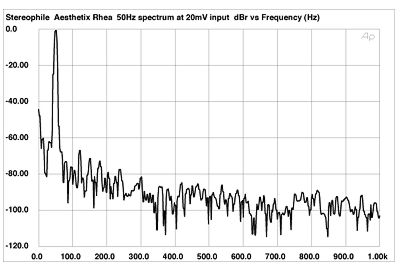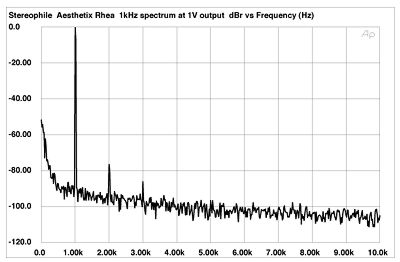| Columns Retired Columns & Blogs |
Aesthetix Rhea phono preamplifier Measurements
Sidebar 3: Measurements
Although its packaging appears as sturdy as I have experienced, the Aesthetix Rhea arrived with the metal mesh panels that ventilate the top cover detached and one of the 6922 tubes loose inside the chassis, suggesting that the box had been dropped. Nevertheless, once I'd reinserted the tube in its socket, the unit appeared to be working, with both channels basically identical in their measured behavior. And having to plug the tube back in gave me a chance to look inside the chassis, whistling through my teeth as I caught my first glimpse of the Rhea's construction quality: drop-dead gorgeous!
Looking first at the input impedance, this was close to that selected, "47k" measuring 46.7k ohms, 1k ohm measuring 1048 ohms, and 250 ohms measuring 271 ohms (all figures taken at 1kHz). The differences will be inconsequential. The preamp's output impedance was a low 110 ohms at 1kHz from the balanced jacks, this rising inconsequentially to 156 ohms at 20kHz but, more significantly, to 3846 ohms at 20Hz. This rise at low frequencies is due to the limited size of the coupling capacitors and implies that the Rhea must be used with a line stage having an input impedance of at least 30k ohms if the bass is not to sound lightweight. The output impedance from the unbalanced RCA jacks was a high 2k ohms across most of the audioband, but as this rose a relatively small amount at 20Hz, to 3.05k ohms, the preamp's tonal balance will be less affected by the line stage having a lowish input impedance.
The Rhea preserved absolute polarity from both balanced and unbalanced outputs. Its voltage gain was higher than the displayed figure. With "50" selected, for example, the actual figure was 53.5dB unbalanced. This +3.5dB difference was maintained across the gain range, with in each case the balanced outputs offereing a further 6dB of gain. The Rhea's intrinsically high gain meant that its signal/noise ratio was not quite as high as I would have liked. With the gain set to "38," for example, the unweighted, wideband S/N ratio (ref. 1V output) was 52dB, this improving to 71dB when A-weighted.
These measurements were taken with a shorting plug in the Rhea's inputs; when the unit was hooked up to the output of either my Audio Precision System One or my Miller Audio Research Analyzer, I couldn't eliminate a 120Hz hum no matter how I arranged the grounding. For many of the remaining measurements, therefore, I used a battery-powered Neutrik signal generator.
Fig.1 shows the Rhea's RIAA equalization error. The bass region is shelved up by a quarter dB or so, which will be just audible as a slight richness. The high-frequency response sensibly rolls off above the audioband. Any crosstalk (not shown) was buried beneath the noise floor.

Fig.1 Aesthetix Rhea, "50dB" gain, RIAA error at 1mV input into 100k ohms (right channel dashed, 0.5dB/vertical div.).
Distortion was moderately low. Figs.2 and 3 show spectral analyses of the Rhea's output with its gain set to "38" while it handled a very-high-level low-frequency tone. Fig.2 was taken with the Rhea driven from the Audio Precision System One; the 120Hz hum I mentioned can be seen as the spike reaching -40dB. Fig.3 was taken with the battery-powered generator; the 120Hz hum has dropped to -68dB, and the actual harmonic components are at or below -70dB.

Fig.2 Aesthetix Rhea, spectrum of 50Hz sinewave, DC-1kHz, at 20mV input, AC-powered signal generator (linear frequency scale).

Fig.3 Aesthetix Rhea, spectrum of 50Hz sinewave, DC-1kHz, at 20mV input, battery-powered signal generator (linear frequency scale).
The same excellent linearity was also evident in the midrange. Fig.4 shows a similar spectral analysis for a 1kHz tone driven balanced at 1V into 100k ohms. The second harmonic is the highest in level, at -77dB (0.014%), and only the third harmonic can be seen above the noise floor. Dropping the load impedance to a punishing 600 ohms gave the spectrum shown in fig.5. The second harmonic has risen to -66dB (0.05%), but the third has disappeared.

Fig.4 Aesthetix Rhea, spectrum of 1kHz sinewave, DC-10kHz, at 1V balanced output into 100k ohms, battery-powered signal generator (linear frequency scale).

Fig.5 Aesthetix Rhea, spectrum of 1kHz sinewave, DC-10kHz, at 1V balanced output into 600 ohms, battery-powered signal generator (linear frequency scale).
The unbalanced output was not quite as linear. Fig.6 is a spectrum of the signal at the output RCAs while the Rhea reproduced an unbalanced 1kHz tone at 1V into 8k ohms. (The right channel's input was shorted, so the red trace shows just the preamp's residual noise. Note that no crosstalk tones are evident.) The actual THD level (the sum of the harmonics, without noise) was a modest 0.186%, with the second harmonic the highest in level at -55dB. The third harmonic lay at -75dB and the fourth at -91dB. The spectrum of a 20kHz tone (not shown) was basically identical, suggesting good high-frequency linearity.

Fig.6 Aesthetix Rhea, spectrum of 1kHz sinewave, DC-10kHz, at 1V unbalanced output into 8k ohms, battery-powered signal generator (linear frequency scale, red trace is undriven right channel's noise floor).
Assessing the overload margin was difficult because of the 120Hz hum. However, the Rhea appeared to be capable of an extraordinarily high output voltage before clipping: almost 45V balanced, 22.5V unbalanced! With the gain set to "50," it took 49.2mV input at 1kHz to reach that output level, equivalent to an overload margin of almost 60dB for a nominal MC cartridge's 500;uV level, the largest I have ever measured. Even at 20Hz, the overload margin was around 35dB, which is excellent. These figures improved at lower gain settings and worsened at higher ones, by the expected amounts.
Other than the problem with 120Hz noise pickup, which could well be specific to my test setup—I note that PB had no problems with hum—the Aesthetix Rhea offers bombproof measured performance.—John Atkinson
- Log in or register to post comments




































